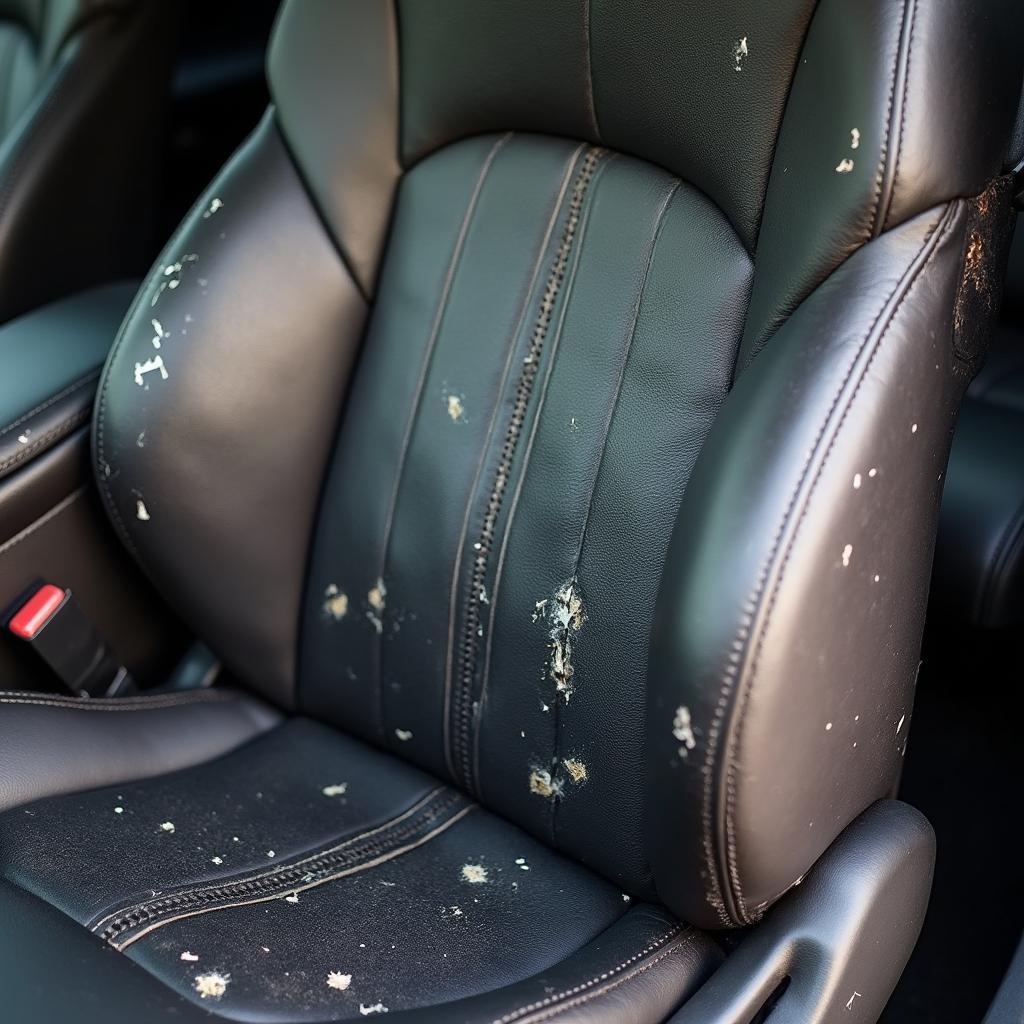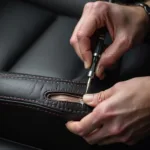Leather car seats add a touch of luxury and comfort to any vehicle. But over time, even the highest quality leather can suffer from wear and tear, scratches, cracks, and fading. So, how much does it cost to breathe new life into your leather car seats?
That’s exactly what we’ll cover in this comprehensive guide. We’ll break down the factors that affect leather car seat repair costs, explore common types of damage and repair methods, and provide you with valuable insights to help you make informed decisions about restoring your car’s interior to its former glory.
Understanding Leather Car Seat Repair Costs
Several factors come into play when determining the cost of repairing your leather car seats:
- Type of Damage: A minor scratch is much cheaper to fix than a deep cut or a tear that requires a patch.
- Extent of the Damage: A single scratch is a simpler fix compared to multiple cracks and widespread discoloration on all your seats.
- Type of Leather: Repairing high-end Nappa leather will likely cost more than repairing standard leather.
- Repair Method: Simple DIY repairs using leather filler and dye will be the most budget-friendly option. However, for serious damage, professional upholstery repair involving stitching, patching, or even replacement panels will be more expensive.
- Location: Repair shops in larger cities or those specializing in high-end vehicles might charge higher labor rates.
 Types of Leather Car Seat Damage
Types of Leather Car Seat Damage
Common Leather Car Seat Damages & Repair Costs
Here’s a breakdown of typical leather car seat damages and their associated repair cost ranges:
1. Scratches and Scuffs:
- Description: Minor surface abrasions that haven’t penetrated the leather’s top layer.
- Repair Methods: Leather filler, color-matched dye, and a leather conditioner can often successfully address scratches.
- Cost: $50 – $200 (DIY) $100 – $300 (Professional)
2. Cracks and Tears:
- Description: Deeper damage that exposes the padding underneath, often caused by aging, sun damage, or sharp objects.
- Repair Methods: For minor cracks, liquid leather filler can be effective. Larger tears might require patching or stitching by a professional.
- Cost: $100 – $400 (Minor, Professional) $300 – $800 (Major, Professional)
3. Fading and Discoloration:
- Description: Loss of color vibrancy often caused by prolonged sun exposure.
- Repair Methods: Leather re-dyeing using professional-grade dyes can restore the original color.
- Cost: $200 – $500 per seat (Professional)
4. Burns and Stains:
- Description: Damage from heat, chemicals, or deeply ingrained substances.
- Repair Methods: Minor burns or stains may be improved with cleaning and conditioning. Significant damage may require patching or panel replacement.
- Cost: $150 – $300 (Minor, Professional) $400 – $1000+ (Major, Professional)
5. Wear and Tear on Bolsters:
- Description: The bolsters (side supports) experience the most friction and often show wear first.
- Repair Methods: Depending on the severity, repair options include leather filler, patching, or replacement of the bolster section.
- Cost: $200 – $600 per bolster (Professional)
Remember that these are just average estimates. The actual cost will vary based on your location, the specific damage, the complexity of the repair, and the chosen repair shop.
DIY vs. Professional Leather Car Seat Repair
Choosing between a DIY approach and hiring a professional comes down to your budget, skill level, and the extent of the damage.
DIY Leather Repair:
Pros:
- Cost-Effective: DIY is the most budget-friendly option.
- Sense of Accomplishment: Repairing it yourself can be rewarding.
Cons:
- Time Commitment: DIY repairs take time and patience.
- Risk of Imperfections: Without experience, you may not achieve professional-looking results.
- Limited to Minor Damage: DIY solutions are not suitable for significant damage like large tears or burns.
Professional Leather Repair:
Pros:
- High-Quality Results: Professionals have the experience and tools for flawless repairs.
- Durability: Professional repairs are typically more durable and long-lasting.
- Handles Complex Repairs: Experts can tackle any type of leather car seat damage.
Cons:
- Higher Cost: Professional repairs come with a higher price tag.
- Finding a Reputable Shop: It’s crucial to find a trustworthy and experienced leather repair shop.
Tips for Choosing a Leather Car Seat Repair Shop
- Seek Recommendations: Ask friends, family, or your local automotive community for recommendations.
- Check Online Reviews: Browse online reviews on platforms like Yelp or Google to gauge customer satisfaction.
- Request Before/After Photos: A reputable shop will gladly share examples of their previous work.
- Get a Detailed Quote: Ensure the quote outlines all costs, including labor, materials, and any potential additional fees.
- Inquire About Warranties: Reputable shops often stand behind their work with a warranty.
Conclusion
Maintaining the pristine condition of your leather car seats enhances the overall driving experience and preserves your vehicle’s value. Understanding the factors that influence repair costs and the range of repair options empowers you to make well-informed decisions about restoring your car’s interior. Whether you opt for a DIY approach for minor blemishes or seek the expertise of a professional for more significant damage, you can bring back the comfort and luxurious feel of your leather car seats.
FAQs
-
Can I repair a ripped leather car seat myself?
You can repair minor rips and tears yourself using a leather repair kit. However, significant tears are best left to professional upholsterers. -
How long does it take to professionally repair a leather car seat?
The repair time depends on the damage’s extent and the repair’s complexity. Minor repairs might take a few hours, while more involved repairs could require a day or two. -
Does car insurance cover leather seat repair?
Typically, standard car insurance policies don’t cover wear and tear. However, if the damage resulted from a covered incident like a collision or vandalism, your insurance might cover it. It’s best to check your policy or contact your insurance provider. -
How can I prevent future damage to my leather car seats?
- Regular Cleaning: Clean your seats regularly using a leather cleaner and conditioner to prevent dirt and grime buildup.
- UV Protection: Use a sunshade or park your car in the shade to minimize sun damage and fading.
- Avoid Sharp Objects: Be mindful of sharp objects that could scratch or puncture the leather.
- Can I change the color of my leather car seats during the repair process?
Yes, professional leather repair shops can re-dye your seats to a different color. This can be a great way to refresh your car’s interior entirely.
Need assistance with your car repair? Don’t hesitate to reach out to our expert team. Contact us via WhatsApp: +1(641)206-8880 or email us at [email protected]. We offer 24/7 customer support.


